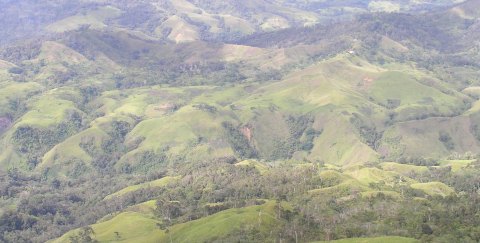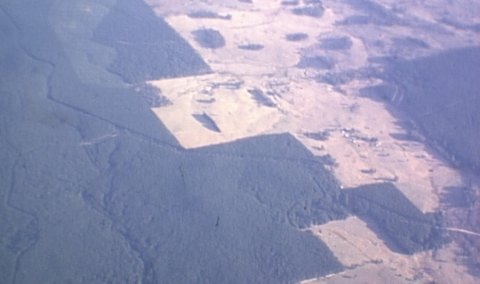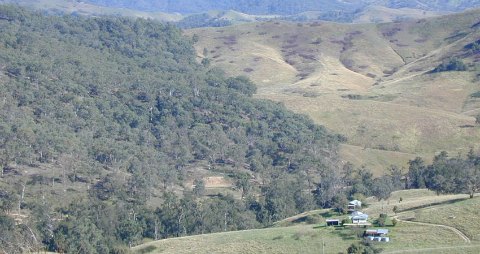Home | About CCW | Contact Us | Climate change Meaning | Causes | Solutions | Emissions | Carbon trading
Forest loss
Forest loss is an ongoing global challenge.
In the western democracies we say that we are worried by the rate of deforestation in tropical forests that is equivalent to an area twice the size of Tasmania every year or an area the size of Sydney every two days. And we are becoming more concerned when we hear that this deforestation, the cutting and burning of carbon stores, makes up around 13% of global greenhouse gas emissions from human activity.
No matter that many of the trees end up providing us with furniture or paper and the cleared land grows cows for our wrapped up burgers.

forest cleared in the highlands of Papua New Guinea
In an attempt to slow the rates of both legal and illegal logging that lead to forest loss, the west is talking up various financial incentives to reduce the rates of deforestation in the tropics. There have been stewardship payments before but this time we are proposing making payments for the carbon that stays in the forest if trees are not cut, an avoided emission.
Several labels have been used to describe this incentive for forest protection. It started as RED, reduced emissions from deforestation. Then a second ‘D’ was added to capture situations when forests are degraded but not felled. And now a ‘+’ has been included to cover the social and economic implications of both deforestation and the incentive mechanism.
So we now have the inclusive REDD+.
The idea is simple enough. An estimate is made of the carbon emissions that would happen if a forest were cut down completely and/or degraded as a result of timber harvest. A detailed set of carbon accounting rules and information on the forest is used to determine the amount of avoided emissions that would accrue from keeping the forest intact. Once the amount of avoided emissions is verified carbon credits can be issued and sold on international carbon markets for areas where the forest is protected. Those with a need for carbon credits and pay the market price for each ton of carbon dioxide to whomever is responsible for keeping the forest intact.
At first glance it seems like a great deal. Local peoples get paid to keep their forests standing and greenhouse gas emitters get to pay to offset their negative effects on the atmosphere.
And where these payments flow and are equal to or greater than the value that would accrue from clearing and cultivating their land, it will seem like a good deal for everyone.

And where these payments flow and are equal to or greater than the value that would accrue from clearing and cultivating their land, it will seem like a good deal for everyone.
Carbon emitters in the west pay real dollars to resource owners in developing countries to keep the trees standing.
Recall, however, what happened in the industrialised countries where just about everywhere land was cleared of forest for agriculture. Less than 3% of Western Europe still has natural forest, down from over 80% before agriculture. In the US where there are large tracts of inaccessible land unsuitable for agriculture where forests are still intact, some 40% of the forests in southern and northern states were cut down during the 1800’s.

Agriculture in these places was hugely successful. Crops were grown and sold each and every year that created wealth and with it innovation, industry and more wealth. Then that wealth created finance that generated even more wealth with lifestyles to match.
So with REDD+ actually we are asking that for modest payments spread out over a few decades and spurning the opportunities of the repeat revenue from agriculture, owners of tropical forests will forego the route to opportunity and wealth that, so far, is the only one we know works.
I wonder how many of us who already live in affluence would take that deal?
Not many is my guess. And yet conservative management of tropical forest loss remains is a critically important task. It is just that we must find an alternative development pathway to mobile phones, plasma TVs, education and health care that is both equitable and reliable.
At some point we must understand that we cannot be so numerous and still try to solve problems on the cheap.
Back to top of forest loss | Return from forest loss to Conservation | Back to climate-change-wisdom home page
Recent Articles
-
Reducing emissions while looking for solutions...
Nov 01, 15 04:46 PM
I've seen a lot of post's online for ideas on reducing emissions. The one suggestion I have not seen, is the most obvious. There should be a government -
Climate change evidence
Mar 24, 15 06:22 AM
Real climate change evidence has to demonstrate a change in climate. An extra sunny day or a severe storm or a flood is not enough. -
The climate change effect
Feb 19, 15 03:08 AM
What will be the climate change effect? There isn't one, there are many. Perhaps too many for us to understand.



New! Comments
Have your say about what you just read! Leave me a comment in the box below.